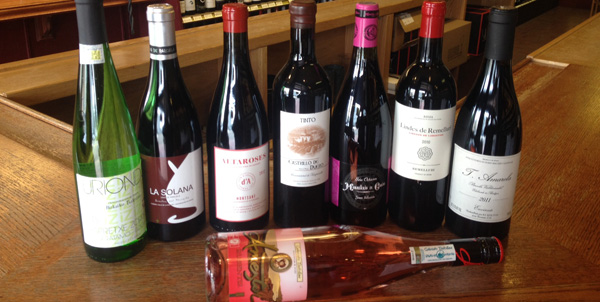Spanish Treasures 20 Wines to Search Out
By Kerry Winslow
Spain has a major generational change going on, in every way this vibrant culture is pulsating with youth and is rethinking it’s future, this kind of change doesn’t come easy and especially with a huge economic depression hanging over the country, but that is what makes this movement even more impressive, even in these dark times, the wines of Spain have never been better and more interesting, there is a real sense of pride of place, experimentation and even a look back to ancient traditions. Spain has Europe’s largest area planted to vine, but is still I believe third in total production, this is because of much smaller yields and tonnage made into wine, behind France and Italy, these numbers have been getting closer in recent times, but the truth is and will be that Spain makes far less tons of grapes per acre than anywhere in the developed wine world, and this translates into more expressive and intense wines. Spain is also western Europe’s value leader, and by far, the wines of Spain even with the Euro at full value are the best priced quality wines in the world. This last year has seen an incredible array of wines being released, and this is just a beginning for a revolution of styles and new faces coming to the fore, this is an exciting time and a new era of Spanish Treasures!
Here are some of my top picks from the year to date, from classic areas like Rioja, Ribera del Duero and Sherry to Cangas and remote Basque regions, these are not to be missed wines! Ole Ole Ole!
The Wines
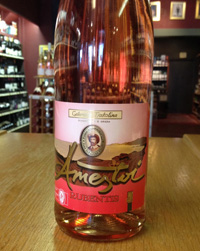 2013 Ameztoi, Getariako Txakolina, Rubentis, Basque Rose, Spain.
2013 Ameztoi, Getariako Txakolina, Rubentis, Basque Rose, Spain.
The zesty Ameztoi Rose is one of the best in Spain, found at almost every pinto bar and is one of the most celebrated seasonal wines of the Basque regions. Ignacio Ameztoi is the 7th generation of this grower/producer and is ensuring tradition and continuing the line of benchmark wines, he makes a white, a red and this lovely and lively rose from his estate near the Bay of Biscay in Northwest Spain. The latest release, the dry, brilliantly pink hued 2013 Ameztoi Getariako Txakolina Rubentis is bright, tangy and has almost a spritz with loads of energy, charm and delicate flavors showing pink citrus, watermelon, tart cherry, sea shore, wet stones, unripe plum and strawberry essence. There is mineral tones and zippy acidity making this wine wonderfully refreshing and crisp, it has that lip smacking zest and saltiness that begs you for another sip and is mouth wateringly good. This makes for a great start to an evening, great for picnics and of course it is great with brunch too, it is all around a fun and smile inducing wine that has everything you’d want from a summer wine being both serious and light hearted, playful yet thoughtful, this is pure joy, drink now and often! Plus try their Blanco Txakoli for a zippy lime infused white too!
($22 Est.) 90 Points, grapelive
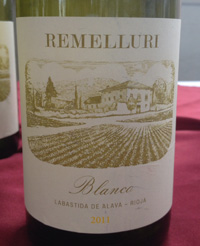 2011 Remelluri, Rioja Blanco, Labastida de Alava, Spain.
2011 Remelluri, Rioja Blanco, Labastida de Alava, Spain.
Since Telmo Rodriguez’s return to his family estate Remelluri, a new direction and drive have found their way into the wines, the latest set of Remelluri are some of the winery’s best to date, especially this amazing 2011 Blanco, it looks set to be a classic, and maybe one of the finest whites in Spain. Telmo always plays coy with his processes from winemaking to varietals, he stresses it is about place and history rather than type of grape or techniques, in our last two meetings now he neither confirms nor denies my guesses as to how and what goes in and on, but regardless this is a fantastic wine, it certainly possesses qualities that lead to comparisons to Meursault, Hermitage and Chateauneuf-du-Pape and wines from Roulot, Coche, Chapoutier, Chave and Beaucastel, and if you wanted to reference California maybe even the likes of Aubert, Peter Michael and Kongsgaard. The Remelluri Blanco 2011 is full and generous, but with refinement and purity, it starts with white flowers, citrus and wet stones leading to a deep palate of sublime texture with apple, peach, honeysuckle, clarified cream, clove, fig, a steely note and lemon curd. There are flashes of tangerine, chalk, butterscotch and apricot along with savory and saline elects, plus a bit of stone fruit pit and a lift of acidity to keep this rich wine in check. This wine is absolutely world class in every detail, I know it has a mix of about 9 varietals including Chardonnay, Roussanne and a few Spanish grapes and was fermented using natural yeasts, some of the wine used cement, some big cask and some stainless, it is a Remelluri original field blend, in fact Telmo tells me that it will be the model he will use on the estate red, going forward he will increase the number of red grapes in the vineyards, he believes it will allow a better canvas to create the best picture of place, I certainly will enjoy watching as the full image emerges, as for now, the Blanco is a masterpiece, near perfection, drink from 2014-2020.
($84 Est.) 97 Points, grapelive
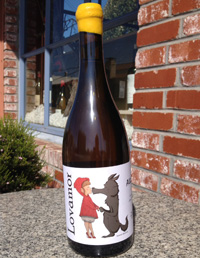 2012 Alfredo Maestro Tejero, Lovamor, Albillo Vino de la Tierra Blanco, Castilla Y Leon, White, Spain.
2012 Alfredo Maestro Tejero, Lovamor, Albillo Vino de la Tierra Blanco, Castilla Y Leon, White, Spain.
This rare old vine white from near Ribera del Duero is made from the scarce and native Albillo grape, this wine comes from 100-120 year old vines grown on clay-limestone at about 800m to 1100m in elevation in a wild and arid stretch of hills. Alfredo Maestro Tejero crafts this natural wine with great care and delicacy using 6 days of skin contact and is fermented and aged in small steel vats, nothing is ever added or are then any adjustments to this intriguing wine. With only around 400 bottles produced, this is exceptional rare juice and will be a hunt to find, a needle in the haystack, but certainly a rewarding endeavor. All of the Bodegas Maestro Tejero wines are worth checking out, these are some of the most innovative and seriously delicious offerings coming out of region. The 2012 Albillo, known as the Lovamor, starts with lime blossom, chalk and savory elements and is a golden yellow with an orange tint from the extended skin maceration and has a raw vigor that is very entertaining and unique. There is lemon/lime, tangerine and peach fruits, melon rind, a hint of tannin, herbs and spice along with a grainy stone essence. I’d really love this wine with savory tapas, smoked fish, cured meats and middle eastern lemon chicken. The 2011 was slightly more nutty and already mature, while the 2012 seems fresher and more lively finishing with lots of zest and tangy elements, both very cool, drink 2014 to 2018.
($34 Est.) 92 Points, grapelive
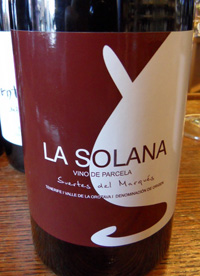 2010 Suertes del Marques, La Solana Vino de Parcela, Tenerife Valle de la Orotava DO, Canary Islands Red, Spain.
2010 Suertes del Marques, La Solana Vino de Parcela, Tenerife Valle de la Orotava DO, Canary Islands Red, Spain.
One of the most exotic and rare wines of the Canaries, the La Solana by Suertes del Marques is a masterpiece of the unique and a marvel of vigor and focus with fruit, spice, umami, mineral and textural pleasure. I adore these wines from the Canary Islands, especially the Suertes del Marques set of 7 Fuentes and this beautiful La Solana. The La Solana is racy and profound with a bouquet of dried flowers, porcini and pepper with mixed berry fruit that leads to a lively palate of spiced plum, raspberry, kirsch and currant with cayenne, grilled fennel and saline notes while warm stones, chalk and silky tannin mix in perfect harmony. This wild and natural wine is utterly seductive and has a wonderful sweet v savory tension that heightens the pleasure factor and leaves you begging for more. This is a thought provoking and beguiling red, made from the native Listan Nergo grape, that will challenge you and keep your attention for a long time.
($30 Est.) 94 Points, grapelive
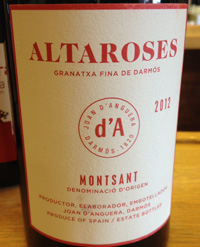 2012 Joan d’Anguera, Altaroses, Granatxa Fina de Darmos, Montsant D.O. Spain.
2012 Joan d’Anguera, Altaroses, Granatxa Fina de Darmos, Montsant D.O. Spain.
A few years back Joan d’Anguera converted to 100% biodynamic farming, changed the winemaking to bring out terroir and restraint and focused on the details in a truly artisan way, and it has paid off with huge rewards, the wines are charming, full of flavor and have a sense of place, these are wonderful wines that show Montsant perfectly in the glass. The Joan d’Anguera wines are some of the finest values in hand crafted Spanish wine, no question and they are just getting better and better, especially their lovely Altaroses Granatxa, a seriously delicious red from old vines. This adorable and stylish Grenache cuvee flows with silky grace across the palate with vivid layers of black and red fruits, spice, mineral and texture, this is pleasure filled experience from start to finish. The nose shows floral essences with hints of wild flowers, dried roses and lavender along with garrigue, minty sage, cracked pepper and raspberry leading to a full mouth of blackberry, plum, lush cherry and wild strawberry while in the background you find a mix of sweet and savory herbs and allspice, chalk, dusty earth, hints of game and licorice. The wine deepens in the glass, but remains lively and focused leaving a long fruit filled aftertaste, drink now and between 2014-2020, it is stupidly good right now, no need to wait.
($18 Est.) 92 Points, grapelive
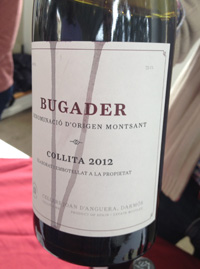 2012 Joan d’Anguera, Bugader, Montsant D.O. Spain.
2012 Joan d’Anguera, Bugader, Montsant D.O. Spain.
The latest set of wines from Joan d’Anguera in Darmos, the 2012’s, are really quite extraordinary and beautifully detailed, this is a big evolution from the past where things seemed almost a bit over the top, and the contrast between the prior vintages to 2012 is vast difference. Where before it was all about big, extracted and port-like the new wines show grace, life and harmony, I think almost everywhere this kind of re-think is going on, but is is at it’s most stark in Spain and in California, though it looks as if Australia might be doing some of same too, it is move to a more natural style, some people use the term balanced, and there is more of a focus on regional, historic and artisan winemaking, along with highlighting terroir, or place over grape or new oak. Not that this change is always perfect or welcome in some cases, and there has been some awkward wines, but not so here, Joan d’Anguera has nailed it, these wines especially the Altaroses 2012 and this magnificent El Bugader (100% Syrah) 2012 are stunning examples and are now all biodynamic as well. While the Grenache based Altaroses remains one of Spain’s great value wines at about $18, the El Bugader is some a bit more dear and it certainly is a special wine, full of delicate detail and exquisite quality, drinking like a fine Cote-Rotie. The 2012 Joan d’Anguera El Bugader Montsant shows perfume, a medium body and suburb length with violets, crushed roses, white pepper, wild herbs, blueberry, boysenberry and kirsch, along with subtle plum, a touch of mineral and gravel, almost flinty and faint traces of game and anise. This wine is pure, thought provoking and excellent, it should be available this fall of 2014, and will drink great over the coming decade, be sure to follow this winery and look for these fantastic 2012 vintage releases. (Pre release sample bottle tasted May, 2014 in SF, CA.)
($75 Est.) 94 Points, grapelive
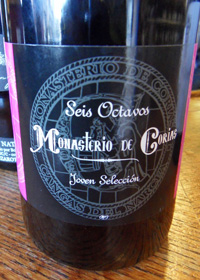 2011 Bodegas Monasterio de Corias, Seis Octavos Joven Seleccion, red Vino de Calidad de Cangas, Spain. (Albarín Negro & Carraquín)
2011 Bodegas Monasterio de Corias, Seis Octavos Joven Seleccion, red Vino de Calidad de Cangas, Spain. (Albarín Negro & Carraquín)
One of my new favorites, a beautiful medium weight red that has elements of character that remind me of St.-Joseph meets Nuits-St.-Georges with dark violets, earth and spices with a core of cherry and plum fruits. The floral and loamy nose leads the way to a vivid palate of the dark fruit, peppery spices, sweet herbs, anise and lavender plus a touch of mineral and stone. Everything is nicely framed by soft tannins and juicy acidity in this delicious red from Spain’s Northwest. This wine is made from vines grown inside the Monastery de Corais in Cangas where the exposure helps get the Albarin Negro and Carraquin red grapes ripe in this cool climate area. Only a tiny amount of this wine gets made and considering the conditions and rarity it is also a steal! This is lovely and unique wine that is done organic and as naturally as can be, and after tasting the last four vintages I highly recommend searching it out.
($18 Est.) 93 Points, grapelive
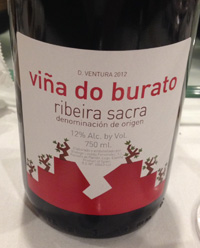 2012 Don Ventura, Ribeira Sacra DO, Vina do Burato, Spain.
2012 Don Ventura, Ribeira Sacra DO, Vina do Burato, Spain.
From the Ribeira Sacra “sacred slopes” this pure Mencia is a vibrant and impressive wine, crafted by the Losada family in the old zone of Amandi. For those looking for flavorful low alcohol reds, you should definitely check out Mencia from Ribeira, and wineries like Don Ventura and Domino de Bibei in the DO of Ribeira Sacra, where you find 12% alcohols and organic and biodynamic practices and still have deep and beautiful wines. Ramon Losada’s entry level Vina do Burato is a steal and shows Mencia in it’s purest form and is unadorned by flashy extras, it simply is lovely and easy to love with bright fruits, spice, hints of game, earth and has plenty of texture and style. The nose is slightly perfumed with traces of dark flowers, green spice and pepper notes like Loire Cab Franc, mineral and tangy currants leading to a medium weight palate of black cherry, plum, mixed berries and wild herbs, stones and dried porcini. The finish is crisp and fresh with youthful acidity and a lingering strawberry note, this is a very nice wine that shows the varietal and region in a solid performance, drink now through 2018.
($20 Est.) 92 Points, grapelive
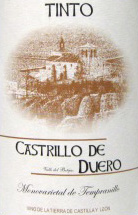 2011 Alfredo Maestro, Tinto Castrillo del Duero, Spain.
2011 Alfredo Maestro, Tinto Castrillo del Duero, Spain.
This is fast becoming one of my favorite Ribera del Duero wines, from the talented Alfredo Maestro, a producer than doesn’t label it thus, preferring to keep his independence. Alfredo Maestro wines mostly come from distinct single parcels or single crus (vineyards), he is capturing terroir and the vines sense of place in unique areas in central Spain from Madrid to Ribera del Duero. The latest release is the rich and darkly detailed 2011, a wine that is hard not to love with nose of morello cherry, dried flowers, raspberry liqueur and soft wood notes, leading to a lush palate of blackberry, cherry and loganberry fruit along with hints cranberry, baking spices, mineral and poached plum, all bright and slightly tangy, with a touch of black licorice before the finish, which turns creamy with warm toffee essence, giving a bit of sweetness. The lingering effect is impressive and seductive, Alfredo Maestro is an artisan winemaker that is ever challenging the boundaries and exploring new paths, be sure to taste his wonderful wines when you see them, especially this monovarietal Tempranillo, drink from 2014-2020.
($28 Est.) 93 Points, grapelive
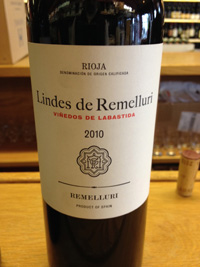 2010 Remelluri, Lindes de Remelluri, Rioja, Vinedos de Labastida, Spain.
2010 Remelluri, Lindes de Remelluri, Rioja, Vinedos de Labastida, Spain.
Telmo Rodriguez, one of Spain’s great winemakers, has turned around his family estate Remelluri in Rioja and he is making some of his finest wines of his prolific career, especially these secondary Remelluri offering from old vine purchased fruit, under the Lindes de Remelluri label. These two vineyard select wines, coming from vineyards that used to go into the Remelluri reserva are now separated into two new single vineyard bottling, and while both are excellent, it is the Labastida that really stands out for me, it comes from a mainly Tempranillo site in Rioja Alavesa where there is higher elevation and unique chalky soils, a very different terroir and character than La Rioja Alta, and it shows in it’s flavors. Telmo, having made wine at Jean-Louis Chave in Hermitage and in Bordeaux, has accomplished himself as a champion of place over varietal and employes artisan craftsmanship in the cellar, his wines hardly ever show oak or alcohol, they always show purity and a sense of place, these are magnificent expressions of Rioja, they are completely distinct and soulful wines that are seriously seductive and charming with style and substance in spades. The 2010 vintage Lindes de Remelluri is 90% Tempranillo and the rest a mix of Garnacha and Graciano, it is a field blend from extremely old vines that provide tiny yields of amazing complex and deep fruit, this 2010 Labastida is impressive, intense and tannic with a garnet/black hue along with a heady perfume and richly textured palate, this is dramatic stuff and will be long aging wine. The nose shows violets, dried flowers and sweet herbs with hints of cedar and blackberry leading to a firm and powerful palate of black cherry, damson plum, blueberry and mixed red and black berry fruits with loam and mineral that remind me of left bank Bordeaux, spice and hints of wild strawberry. There is a tangy currant running throughout and lingering liqueur cassis feel in the same vein, and some lavender, licorice and earthiness rounding out the complexity in this dense and layered Rioja. This is captivating and fantastic wine, this is not to be missed and certainly is another feather in Telmo’s cap, drink this gorgeous beauty over the next two decades, no question a great cellar candidate, this is an affordable collectors item, best from 2018 to 2035.
($30-35 Est.) 94 Points, grapelive
 2009 Remelluri, Rioja, Reserva, Spain.
2009 Remelluri, Rioja, Reserva, Spain.
Telmo Rodriguez returned to his family estate in 2010, but had plenty of time in the cellar to separate lots and refine the blend in this sublime Rioja that for the first time in modern history was all estate grown, with the purchased old vine fruit going into the Lindes de Remelluri bottling. Telmo has great plans for this glorious estate wine, and his estate white, the Remelluri Blanco is already seeing his vision come into focus, he plans to model the red along the same lines, he will add more varietals each year until he has up to 9 or 10 different grapes to the classic mix of Tempranillo, Garnacha and Graciano, his idea is craft a unique field blend that is proprietary to Remelluri a more complex and exotic wine. I can see why, as his Blanco proves he’s on to something special here, the terroir is ideal for this too with slopes and high elevation Remelluri has it’s own sense of place, quite different to other properties in Rioja, Remelluri is literally on the edge with a mix of soils and it’s own micro-climate in Rioja Alavesa. 2009 was a warm and generous vintage, and the Remelluri is full of richness and texture with ripe tannins and wonderful length, Telmo’s masterful touch in blending gave this wine a graceful almost Burgundy like feel, it is rich without being heavy, no mean feat in this vintage. Pretty red fruits, earth, spice and subtle wood notes all play important roles here with raspberry, cherry and dark plum. There is texture and layers here, with hints of game, exotic spice, truffles, anise, cedar and warm stones, this is an interesting wine and it sets the senses alight, drink now and through 2019. Be sure to keep an eye out for future releases of Remelluri, and don’t miss the Blanco, the 2011 is stunning!
($45 Est.) 93+ Points, grapelive
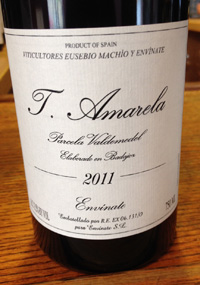 2011 Envinate, T. Amarela, Parcela Valdemedel Elaborado en Badajox, Extremadura, Spain.
2011 Envinate, T. Amarela, Parcela Valdemedel Elaborado en Badajox, Extremadura, Spain.
The grape Tinta Amarela is one of the Port grapes and is widely planted in the southern part of Portugal, though it is rarely found in Spain itself, it makes for a rich and complex wine. This wine comes from Badajox in Extremadura Spain, a south-western part of the country, land locked and bordered by Portugal to the west, so it is not terribly surprising to find this grape here, though I can tell you it is very uncommon to find it as a single varietal wine and especially as a Spanish one, this was my first experience tasting it and research proved much more difficult, but I did learn of the grapes heritage and use in some Port wines and that it is a fickle vine that easily rots, so great care must be used to get successful results and that Tinta Amarela, also known as Trincadeira, does well in these dry warm regions, making a wine of deep color and complexity. The Envinate range of wines is interesting, the winery is a brainchild of four friends that met in viniculture school in Alicante, who all make wine in different regions from Northern Spain to the Canary Islands, they are lead by Laura Ramos and include Jose Martinez, Alfonso Torrente and Tenerife native Roberto Santana who’s Canary Island wines at Suertes del Marqués are really turning some heads, and of which I’m a huge fan of personally. The Envinate (meaning “Do Wine Yourself”) wines are very limited to say the least, and this T. Amarela is a beautiful red wine with deep color and flavors done in a wonderfully elegant and very artisanal in style, showing unique terroir driven flavors and lovely transparency. The 2011 Envinate T. Amarela starts with dried roses and wild flowers, juicy plum, sweet mountain herbs, red berries and currants leading to a medium full palate of blackberry, red peach, tangy cherry and star anise along with warm stones, hosin and dusty earth. There is hints of leather, red spice and the texture is caressing helping to lengthen the finish which lingers with blue and black fruits. I must say I’m very intrigued and impressed, I would enjoy tasting all of their offerings and recommend finding their exotic wines, like this very compelling rarity, drink now and for the next 3 to 5 years.
($45 Est.) 92 Points, grapelive
Sherry
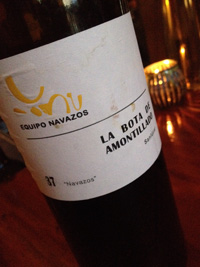 n.v. Equipo Navazos, Sherry, La Bota de Amontillado no. 37, Hijos de Rainera Pérez Marín “Navazos” Sanlucar de Barrameda, Jerez-Xérès DO, Spain.
n.v. Equipo Navazos, Sherry, La Bota de Amontillado no. 37, Hijos de Rainera Pérez Marín “Navazos” Sanlucar de Barrameda, Jerez-Xérès DO, Spain.
This unbelievable Sherry is drop dead gorgeous and complex, only 3,000 bottles of this rare Amontillado were made from unique casks, this No. 37 is drawn lots of Hijos de Rainera Pérez Marín, hand selected by Equipo Navazos which is fast becoming the exciting Sherry shipper in the world and is putting the passion into these stylish expressions. The La Bota de Amontillado P. Marin 37 Navazos is a rare solera that has selected and refreshed with pure Manzanilla (unfortified) to add dynamic character and verve, which also heightens the aromatics and gives life to this deeply flavored and complex Sherry, without question this is one of the most interesting and pleasing Sherry wines I’ve tasted. The nose is tangy/nutty, briny and vibrant with citrus, pear, sea breeze and has green almond notes leading to a vivid palate of lemon, peach and tangerine with pecan oil, wild herbs, unsweetened salted caramel/toffee and burnt orange rind. This fine dry and dusty Amontillado gains richness with air, but is wonderfully fresh and crisp, and it is not overly oxidized, leaving a lip smacking sensation and is hauntingly long and lingering. Wow, wow and more wow, if you want to taste what great dry Sherry is all about, find this one, this is fantastic, a big thank you to Duende Tapas Bar in Oakland for pouring this one by the glass, bravo! Ole, Ole, Ole!
($60-70 Est. 750ml, 18.5% alc.) 95 Points, grapelive
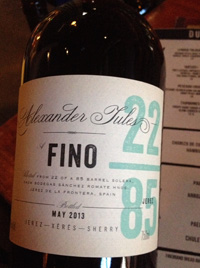 n.v. Alexander Jules, Fino Sherry “22|85” Bottled May 2013, Bodegas Sanchez Romate, Jerez de la Frontera, Jerez-Xeres-Sherry, Spain.
n.v. Alexander Jules, Fino Sherry “22|85” Bottled May 2013, Bodegas Sanchez Romate, Jerez de la Frontera, Jerez-Xeres-Sherry, Spain.
Alex (Jules) Russan is a Sherry fiend and absolute believer in all things Sherry, so created his own label and hand picks casks to bottle, each of his offerings is a limited, rare barrel select that makes up a one time release. He sources many small and big Bodeags to find that unique profile and intriguing character, and I really admire what he’s done with his Alexander Jules lineup and his focus on dry styles, that he hopes people with take to the table with meals, and I adore this wonderful and vibrant Fino “22|85” that I just recently sampled at Duende Tapas Bar in Oakland, California. The “22|85” Fino is a select Sherry that would have been known in the past as a Fino Amontillado, it was hand picked from 22 of the 85 Celestino Solera barrels at Sanchez Romate Hnos. in Sherry’s Jerez de la Frontera, is is from the oldest lots of Fino, an average age of 8 years, this adds weight, complexity and mature details, while remaining dynamic and fresh from start to finish. The May 2013 bottling is current and only 1,100 Bottles were made, only in 750ml and interestingly it is only offered in the USA, and it comes in at 15% Alc. If you are looking for a richer style, you should also check out the fantastic Amontillado from Alexander Jules, it is also sublime. This vivid Fino starts with hints of white flowers, iodine, brine and pecan butter and dives into a fresh, tangy palate that shows citrus, peach, dried apricot, tangerine rind, cheesy notes, wild herbs, baking spice and bitter almonds along with a faint trace of mineral and zesty acidity with a lingering nuttiness, this is crisp and lovely Sherry that needs food, delivering precise focus and is pleasingly well rounded, bravo.
($32-40 Est. 750ml) 92 Points, grapelive
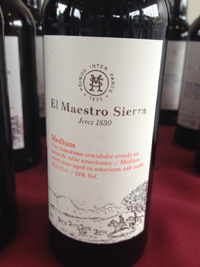 n.v. El Maestro Sierra, Medium Amoroso, Semi-Sweet Sherry, Jerez, Spain.
n.v. El Maestro Sierra, Medium Amoroso, Semi-Sweet Sherry, Jerez, Spain.
The famed El Maestro Sierra bodega was founded in the early 1800’s by a master woodworker named Jose Antonio Sierra and quickly became one of the regions most treasured Sherry houses and even today some of those early glories remain, it still has many old and rare stocks, making it the destination for visits to Jerez, and one of the most sought after wineries in the world. I was lucky to taste through an amazing array of fine Sherry and El Maestro Sierra is on another level with some of the oldest Sherry wines available and many gorgeous offering throughout their latest offerings, including a majestic Palo Cortado, a deftly crafted dry Fino and sweet and balanced Pedro Ximenez, but I think my favorite was this spectacular Medium Vino Amoroso. The El Maestro Sierra version of “Cream” Sherry is a world class semi-sweet dark Sherry aged in American oak cask and gets additional years of age in a solera, it is made from a base of 15 year Oloroso (Palomino) about 90% and 15 year Pedro Ximenez 10% (this is where the rich sweetness comes from) and trust me this is not Harvey’s Bristol Cream, this is magnificent and decedent fortified wine that has almost tawny port elements but not as sweet. The Amoroso is filled with Walnut, pecan and oily almond layers along with maple, honey and toffee notes with a core of dried peach, orange rind and tropical fruit. This is rich, mouth filling and long on the finish it is marvelous with smoked ham, cheeses, nuts and can be sipped on it’s own, this is a stunner and a great entry into the world of Sherry.
($18 Est. 375-Half Bottle) 94 Points, grapelive
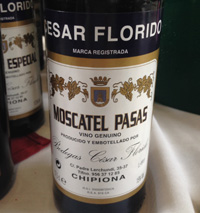 n.v. Bodegas Cesar Florido, Moscatel Pasas, Sweet Sherry, Chipiona, Jerez DO, Spain.
n.v. Bodegas Cesar Florido, Moscatel Pasas, Sweet Sherry, Chipiona, Jerez DO, Spain.
This Bodega was originally founded in 1887 and is still in family hands today, run by Cesar Florido in the Jerez sub-zone of Chipiona, an area of sandy soils that is home to mostly Moscatel vines very near the ocean. While they also make some fine dry sherry, it is their semi and sweet styles that really grab the limelight and the Moscatel Pasas is center stage, this is glorious sweet sherry that is unique and gorgeous with delicate and seductive perfume, medium sweetness and with a salty/savory nutty element adding balance and complexity. the nose stators with jasmine, dried yellow roses, verbena and honeysuckle before giving way to candied pineapple, dried apricots, orange rind, caramelized apple and poached spicy pear along with pecan and hazelnuts, plus briny sea breeze and toffee. What is remarkable in the whole and the fact that it is not cloying with life and tanginess making for a complete and detailed wine (Sherry) which can be enjoyed with many foods and not solely for desserts, it certainly would be wonderful with cheese as well. This is a very excellent example of a somewhat rare style and of this varietal from a region that deserves much grander attention, do not be afraid to explore the world of Sherry it is a wonderful adventure.
($14 Est. 375ML-Half Bottle) 93 Points, grapelive
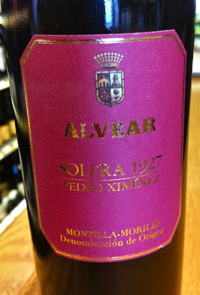 nv Alvear, Pedro Ximenez Solera 1927, Montilla-Moriles DO, Spain (sweet sherry style wine) 375ml Half Bottle.
nv Alvear, Pedro Ximenez Solera 1927, Montilla-Moriles DO, Spain (sweet sherry style wine) 375ml Half Bottle.
Alvear, a sherry style producer just outside the “Sherry Zone” in Montilla-Moriles is one of the oldest wineries in Spain and specializes in fine crafted wines, mostly Pedro Ximenez (grape) with a wealth of great offerings from Fino dry to PX sweet, of which all are excellent, especially the stickies like this fantastic Solera 1927. Alvear only taps the 1927 cask twice a year to make this selection of sweet solera, and it’s age and grace shows through with creamy richness and complexity of flavors. This wine is a rare treat, and one of the best deals in the wine world, no question, I am always amazed by this beauty, and even more amazed people still fear sherry in general, it makes me turn evangelical for these too often overlooked gems! The latest edition of Alvear Pedro Ximenez Solera 1927 shows the deep dusty coco powder and dark amber hue and the nose leads with chopped walnuts, candied orange rind, honey and dried figs with a creamy lush palate of toffee, honeyed pecans, almond paste, bitter chocolate and golden raisins with a touch of dried stone fruit and a hints of citrus. This pleasure filled PX must be tried on it’s own, but of course for added hedonistic joy enjoy this over organic vanilla bean ice cream, this is naughty sexy stuff that can replace Tawny Port on your after dinner menu and goes great with a variety of desserts.
($25 Est.) 94 Points, grapelive
Vermouth
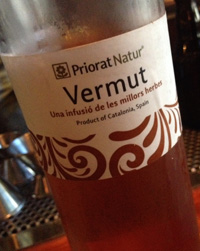 n.v. Priorat Natur, Vermut, Priorat, Catalonia. (Spanish Vermouth)
n.v. Priorat Natur, Vermut, Priorat, Catalonia. (Spanish Vermouth)
I don’t write about wine based Cocktails or Aperitifs very often and almost never mention Vermouth, but I couldn’t pass on the chance to comment on this sexy and compelling Priorat Natur, all organic Vermouth from Catalonia made with native herbs and aromatics infused into a wine base using a combination of Macabeo, Pedro Ximénez and Grenache Blanc grapes that are fermented on the skins and then aged at least two years. Xavier Buil and his wife Anna Cuadrat hand craft this delicate and intriguing Vermouth using natural and ancient methods with hundreds of local botanicals and a touch of sugar in this amber hued elixir, they add young Vermut to a barrel of old Vermut to create the richly flavored complexity, much like a solera you’d find in Jerez. Recently I’ve had the chance to examine many Vermouths from Spain and these are superb Aperitif, and with the Negroni craze out of control these days, you can find some amazing offerings using these distinct Spanish Vermouths, plus you can do some very racy Manhattans and other stylish cocktails with them, though I prefer to enjoy them sans booze, just chilled, especially this Priorat Natur Vermut, this is gloriously refined and joyous on it’s own. I was sipping this wonderful Vermouth with Tapas the other evening after it was recommended at the bar (Duende Tapas in Oakland, Calif.) and it went down beautifully, it is truly an artisan product with not too much sweetness, it shows bright dried fruits, tangy herbs and perfumed florals that all add up to a light and restrained example with citrus, clove, thai basil, a hint of wild honey, fig and almond.
($22-30 Est.) 91 Points, grapelive
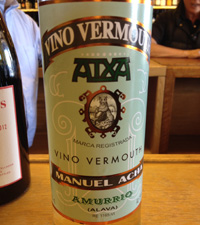 n.v. Destillerias Manuel Acha 1831, Basque Vino Vermouth Blanco, Amurrio (Alava)Spain.
n.v. Destillerias Manuel Acha 1831, Basque Vino Vermouth Blanco, Amurrio (Alava)Spain.
Wow, this is dusty dry and crisp vino Blanco Vermouth that begs to be in your ultimate Martini, and or as a fine sipping aperitif, this is great stuff made from all natural ingredients and using ultra traditional methods. The Manuel Acha family distillers in the Basque region of Amurrio makes a fine artisan Vermouth and is now run by the talented Gabriel Acha, continuing the long line of Acha’s to craft unique Basque Vino Vermouth. The Blanco is savvy and brisk with loads of citrus oil, tangy white peach and lime with crushed jamming, orange blossom and bitter herbs. On the rocks or straight up with a lemon twist this makes for a great palate awakener and again, if you want a stylish and racy Martini, this is your stuff, no question, I was left very impressed by both the white dry and the semi sweet and delicate red by Acha, I would for sure make these my bar staples. The Acha (Atxa) Vermouth is complex and layered, and stunningly good, even for someone like me that rarely indulges in mixed drinks or cocktails, I’m going to make sure I have both these around, this is quality stuff, exotic and charming, especially this dry Blanco, bravo!
($20 Est. 750ml) 93 Points, grapelive
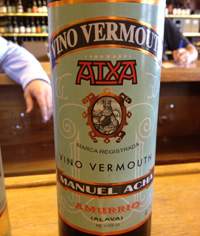 n.v. Destillerias Manuel Acha 1831, Basque Vino Vermouth Rojo, Amurrio (Alava) Spain.
n.v. Destillerias Manuel Acha 1831, Basque Vino Vermouth Rojo, Amurrio (Alava) Spain.
Acha’s, or Atxa in Basque, sweet red Vermouth is super tasty and maybe one of the world’s great Manhattan ingredients and makes for a super Negroni too, but frankly this stuff is so delicious you can serve straight chilled, and I secretly think a great sangria would enhanced using a touch of this wonderful stuff. Gabriel is a long line of Achas that have been making artisan Vermouth since 1831, he crafts all natural Basque vino Vermouth using local organic grapes and herbs. The pay of bitter and sweetness is near perfect and very exciting, much less cloying than the Italian offerings with little of the overwhelming vanilla, this is more delicate and subtle with complexity and flair, very Basque indeed. This aperitif makes for great sipping and even better cocktails with floral extracts, lavender, fennel, sweet sugar beet and classic red berry wine character along with liqueur dipped plum and candied citrus rind. Richly detailed on the palate and easy to love, if you are looking for excitement in your Vermouth and want something truly unique and special you really need to find this great product made myth passion and tradition.
($20 Est. 750ml) 92-94 Points, grapelive
Stay tuned, there are hundreds of great new Spanish wines coming!
